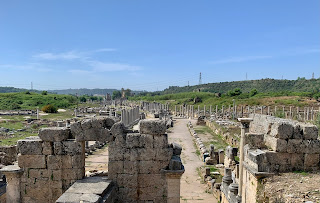 |
| Main Street |
 |
| Stadium exterior |
 |
| Stadium interior |
Originally known as Perga, this place has been part of recorded history for at least 3,000 years; back when this was area was part of the Hittite Empire. Speaking of which, the English word “wine” traces it’s roots back to the Hittite word “wiyana.” The locals have been making wine around here since God was a boy and I can attest that it is still pretty tasty.
Greeks and Persians passed through Perga on a regular basis. One of the Greeks was a young lad named Alexander the Great. Apparently, he lined all of his troops up outside the city gates and the city fathers opened up without a fight.
As usual, the Romans eventually showed up and expanded Perga greatly. A good guess is that the population reached 70,000 at one point. For a while it was run by a woman named Plancia Magna.
In the 1st century AD, a boy from Tarsus – just down the coast – came through here. St Paul’s visits to Perga are recorded in the Bible.
The high point for Judy, however, had to be the 12,000 seat theatre.






No comments:
Post a Comment